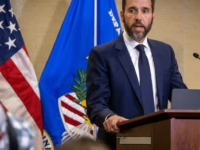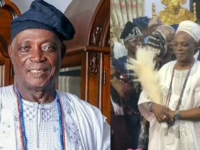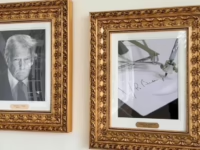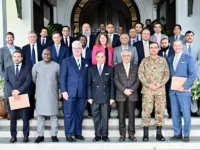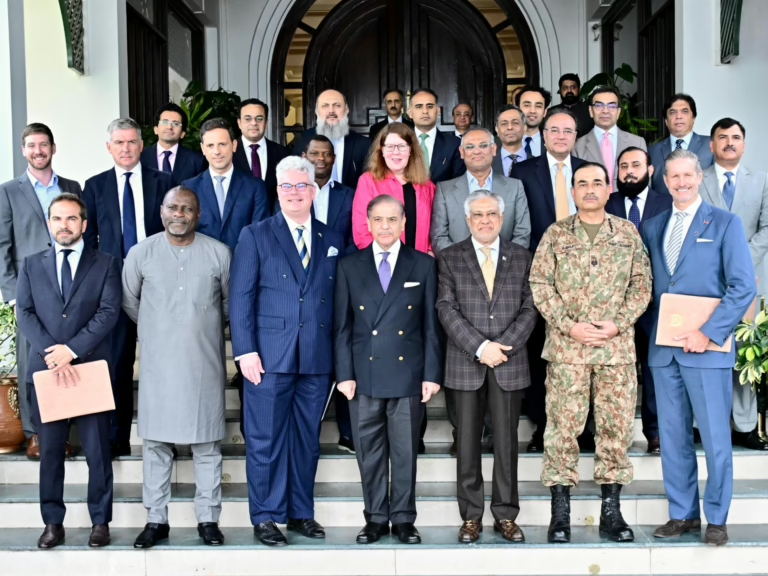Islamabad, Pakistan – As Pakistan’s Prime Minister Shehbaz Sharif prepares to meet US President Donald Trump at the White House this Thursday, he brings with him a commitment that sets his visit apart from those of previous leaders.
Historically, Pakistan’s strategic importance to the United States was anchored in its role as a security ally-initially during the Soviet invasion of Afghanistan and later throughout the global “war on terror.”
Recommended Stories
list of 4 itemsend of list
However, this alliance gradually deteriorated amid growing skepticism within US strategic circles-and from Trump himself-who accused Islamabad of duplicity, especially after the discovery of Osama bin Laden in Abbottabad, Pakistan.
Yet, a recent high-profile signing event at the Prime Minister’s residence earlier this month revealed a fresh dimension to Pakistan’s engagement with the US. On September 8, two memorandums of understanding (MoUs) were formalized in a ceremony attended by Sharif, Pakistan’s army chief Field Marshal Asim Munir, and senior officials from both nations.
The centerpiece of these agreements involves Pakistan supplying critical minerals and rare earth elements to the United States, following Trump’s July announcement to collaborate with Pakistan on developing its “vast oil reserves.” A US-based company is committing $500 million to invest in Pakistan’s mineral sector.
This new approach seems to be bearing fruit amid a broader thaw in US-Pakistan relations-something few experts anticipated when Trump, who in 2018 accused Pakistan of offering “nothing but lies and deceit,” returned to office earlier this year.
In a March address to Congress, Trump acknowledged Pakistan’s role in counterterrorism efforts, and US military officials have similarly praised the partnership. Pakistan publicly supported Trump for a Nobel Prize in June after a brief conflict with India, which both Washington and Islamabad claim he helped mediate.
Notably, the 19 percent tariff imposed by Trump on Pakistani imports is the lowest among South Asian countries-India, Pakistan’s regional rival and America’s favored partner for decades, faces tariffs as high as 50 percent. Munir’s visit to the White House marked the first time a Pakistani army chief, who is not a head of state, was hosted there. Meanwhile, Sharif’s upcoming visit will be the first by a Pakistani prime minister to the US president’s residence since 2019.
This shift in US policy is remarkable, and analysts suggest Pakistan’s mineral export promise could be a pivotal factor. The US is actively seeking reliable sources of minerals and rare earths critical for its industrial, defense, and clean energy sectors, and Pakistan may emerge as a promising, though still unproven, supplier.
“This is more than just an economic deal; it’s a strategic alliance blending resource diplomacy with symbolic realignment,” a former Pakistani three-star general, speaking anonymously, told Al Jazeera.
“It’s about controlling the essential materials that will shape the future. For Pakistan, it’s an opportunity to redefine its mineral wealth as a source of national pride and legacy. For the US, it’s a calculated move in the global contest over resource dominance.”
From Memorandum to Mining: What Does the Agreement Entail?
During a minerals summit in April, PM Sharif highlighted that Pakistan’s mineral reserves, estimated to be worth “trillions of dollars,” could revolutionize its struggling economy burdened by $130 billion in external debt.
Five months later, a significant agreement was inked between the Frontier Works Organisation (FWO)-a military-led engineering and construction entity headed by a two-star general-and United States Strategic Metals (USSM), a Missouri-based firm established in 2018.
USSM specializes in recovering critical minerals from recycled lithium-ion batteries and mining metals such as cobalt, nickel, and copper.
According to Sharif’s office, the partnership will immediately commence exporting “readily available minerals” like antimony, copper, gold, tungsten, and rare earth elements from Pakistan.
The statement further noted that the MoU aims to eventually establish a dedicated refinery in Pakistan to produce intermediate and finished products tailored to meet the growing demand in the US market.
“The initial phase of this agreement anticipates approximately $500 million in investments into Pakistan’s critical minerals sector,” the prime minister’s office stated, adding that future phases will focus on exploring and developing the country’s broader mineral resources.
It is important to note that the MoU does not grant a mining license but serves as an early-stage expression of intent.
“For USSM, the MoU represents goodwill and early engagement in potential projects, allowing flexibility to prioritize deposits with the quickest potential,” explained Zain Kazmi, COO of Islamabad-based Capital Strategies Group and advisor to the Washington DC-based Critical Minerals Forum.
A senior government geologist familiar with the deal, speaking anonymously, emphasized the focus on “strategic minerals and rare earth elements,” pointing to ongoing projects involving copper and antimony.
“FWO currently operates mines in the Waziristan region of Khyber Pakhtunkhwa and holds exploration licenses in the Chaghi Belt of Balochistan and Gilgit-Baltistan,” the official said.
However, he cautioned that mining ventures typically span “five to 15 years” before yielding results.
“The plan under this MoU appears to be to first export minerals like antimony and copper that are readily available, then develop processing facilities, and finally expand exploration activities,” he added.
Understanding Rare Earth Elements and Critical Minerals
The escalating technological competition between China and the United States has intensified the demand for rare earth elements and other critical minerals.
Rare earth elements comprise 17 metallic elements essential for manufacturing products ranging from smartphones and electric vehicles to semiconductors and defense equipment.
Despite their name, these elements are relatively abundant in the Earth’s crust but are often scattered or combined with other materials, making their extraction complex and expensive.
The US Geological Survey (USGS) and Department of the Interior maintain a list of 54 “critical minerals” vital to the US economy, including copper and silver, many of which are crucial for clean energy initiatives and advanced manufacturing.
In its January 2025 minerals commodities report, the USGS identified 15 countries with mapped rare earth deposits; Pakistan was not listed among them.
Pakistan’s Mineral Wealth: From Balochistan to Gilgit
Moin Raza Khan, former managing director of Pakistan Petroleum Limited and now a consultant based in Karachi, estimates that about 25 percent of Pakistan’s landmass contains geological formations likely to harbor critical minerals.

Most of this potential is concentrated in Balochistan, Khyber Pakhtunkhwa, and the mountainous Gilgit-Baltistan region-areas challenged by difficult terrain and security issues.
As Khan explains, these regions face “either geographical obstacles, political instability, or both.”
Balochistan, Pakistan’s poorest province with around 15 million residents, is rich in natural resources but remains economically underdeveloped.
Khyber Pakhtunkhwa has experienced increased violence, with Islamabad accusing armed groups of crossing from Afghanistan into tribal districts like South and North Waziristan, which are believed to hold significant mineral reserves.
The most economically significant deposits are copper reserves in Balochistan, notably Saindak and Reko Diq.
Saindak, near the Iranian border, was discovered in the 1970s, with commercial mining initiated by China’s Metallurgical Construction Corporation (MCC) in the early 2000s. Copper exports from Saindak reached $842 million in 2024, up from $777 million the previous year.
Reko Diq, located less than 150 kilometers from Saindak, is considered one of the world’s largest untapped copper and gold deposits.
Canada’s Barrick Mining holds a 50 percent stake in Reko Diq, with the remainder owned by federal and provincial governments and state entities.
“Reko Diq’s proven and probable reserves are estimated to contain about 15 million tonnes of copper and 26 million ounces of gold,” Khan told Al Jazeera.
He valued the metal content at over $190 billion, with copper accounting for approximately $138 billion and gold about $53 billion.
However, comprehensive data remains scarce. Muhammad Yaqub Shah, former director of the Pakistan Mineral Development Corporation, noted that while Pakistan likely has significant mineral prospects, detailed scientific exploration is necessary to accurately assess them.
Kazmi concurred, stating, “Except for Reko Diq, there are no fully measured reserves in Pakistan. The mining sector is still in its infancy, and all projects are greenfield, so it will take time to confirm these resources.”
Between Ambitions and Reality
Despite government enthusiasm for the MoU, requests for comments from the petroleum minister and other officials went unanswered.

Critics urge caution, warning against “overly optimistic projections” and recalling past announcements that failed to materialize.
This skepticism is grounded in history. On July 31, Trump tweeted his intention to collaborate with Pakistan on developing its oil reserves, a statement that puzzled many given Pakistan’s limited proven crude oil resources.
Pakistan currently spends about 31 percent of its import budget on fuel, importing roughly 80 percent of its petroleum needs.
In May 2019, then-Prime Minister Imran Khan declared a “jackpot” discovery of oil and gas off the Arabian Sea that was expected to meet Pakistan’s energy needs for decades.
However, these wells were soon abandoned after failing to produce commercially viable quantities.
Similar unverified claims resurfaced in September 2024 when a senior military official spoke of discoveries that could “transform the nation’s future.”
Earlier this month, a retired naval officer claimed that Pakistan and China had jointly identified potentially large gas reserves during a survey-claims that remain unconfirmed.
Khan, the Karachi-based analyst, questioned whether USSM possesses the necessary expertise to carry out the exploration and mining required to fulfill Pakistan’s mineral ambitions.
USSM’s profile emphasizes recycling metals from spent lithium-ion batteries and reprocessing cobalt mine tailings at its Missouri facility. Tailings are residual materials left after ore processing that may contain traces of other metals, including rare earth elements.
“At present, it seems they aim to export concentrates and operate more like a trading company than a mining firm,” Khan observed.
Nonetheless, Kazmi noted that the MoU with USSM could serve as a valuable initial signal to attract larger, more experienced investors, marking “the entry of high-caliber interest into Pakistan’s mining sector and opening doors for top-tier mineral processors and investors.”
Minerals and the Challenge of Geopolitical Equilibrium
The critical minerals agreement with the US also presents a complex test for Pakistan’s geopolitical balancing act.
Over the last decade, Pakistan has strengthened economic ties with China through the $62 billion China-Pakistan Economic Corridor (CPEC), a vast infrastructure initiative.
Chinese investments, especially in Balochistan, have sparked local resentment, with communities accusing Chinese companies of exploiting local resources. Nationalist insurgents have repeatedly targeted Chinese workers and facilities.
Official data indicate nearly 20,000 Chinese nationals reside in Pakistan, with at least 20 killed since 2021 in attacks linked to these projects.
For Beijing, ensuring security is paramount, and the introduction of US investments in these sensitive regions could complicate an already volatile situation, analysts warn.
Uzair Younus, principal at the US advisory firm The Asia Group, interprets the minerals MoU as a sign of Pakistan’s willingness to welcome Western investors into strategic sectors, signaling that Balochistan will not be exclusively dominated by Chinese interests.
“From China’s perspective, this development could be beneficial, as American involvement might help suppress insurgencies fueled by regional proxies in Balochistan,” Younus told Al Jazeera. “Any attacks would risk antagonizing not only Pakistan and China but also the US.”
Economic benefits from US investments could also indirectly support China by unlocking commercial opportunities essential for servicing Chinese loans and investments in Pakistan’s infrastructure projects, he added.

Islamabad-based security expert Amir Rana believes that while China may have hoped to monopolize Pakistan’s mineral sector, he does not expect this new dynamic to significantly damage Sino-Pakistani relations.
Kazmi emphasized that from a commercial standpoint, it is prudent for Pakistan to engage multiple partners.
“No foreign country has unrestricted access to Pakistan’s resources; Pakistan retains sovereign rights over its deposits,” he said.
Local Communities, Security, and Equitable Revenue Distribution
Despite the promising agreements, Pakistan faces significant challenges in delivering concrete results that translate into commercial success and investor confidence, according to Younus in Washington, DC.
“Failure to demonstrate progress will reinforce perceptions that Pakistan’s instability makes it a difficult environment for business,” he warned.
The retired army general, speaking anonymously, stressed that true transformation in conflict-affected regions requires more than just foreign investment.
“Success in this sector demands moving beyond militarized control toward inclusive development, empowering local communities as custodians of their land, ensuring transparent royalty sharing, and building infrastructure that supports both extraction and human dignity,” the general said.
“Only by redefining mineral wealth as a shared national heritage rather than a contested asset can Pakistan convert its untapped resources into a foundation for unity, sovereignty, and regional influence.”





